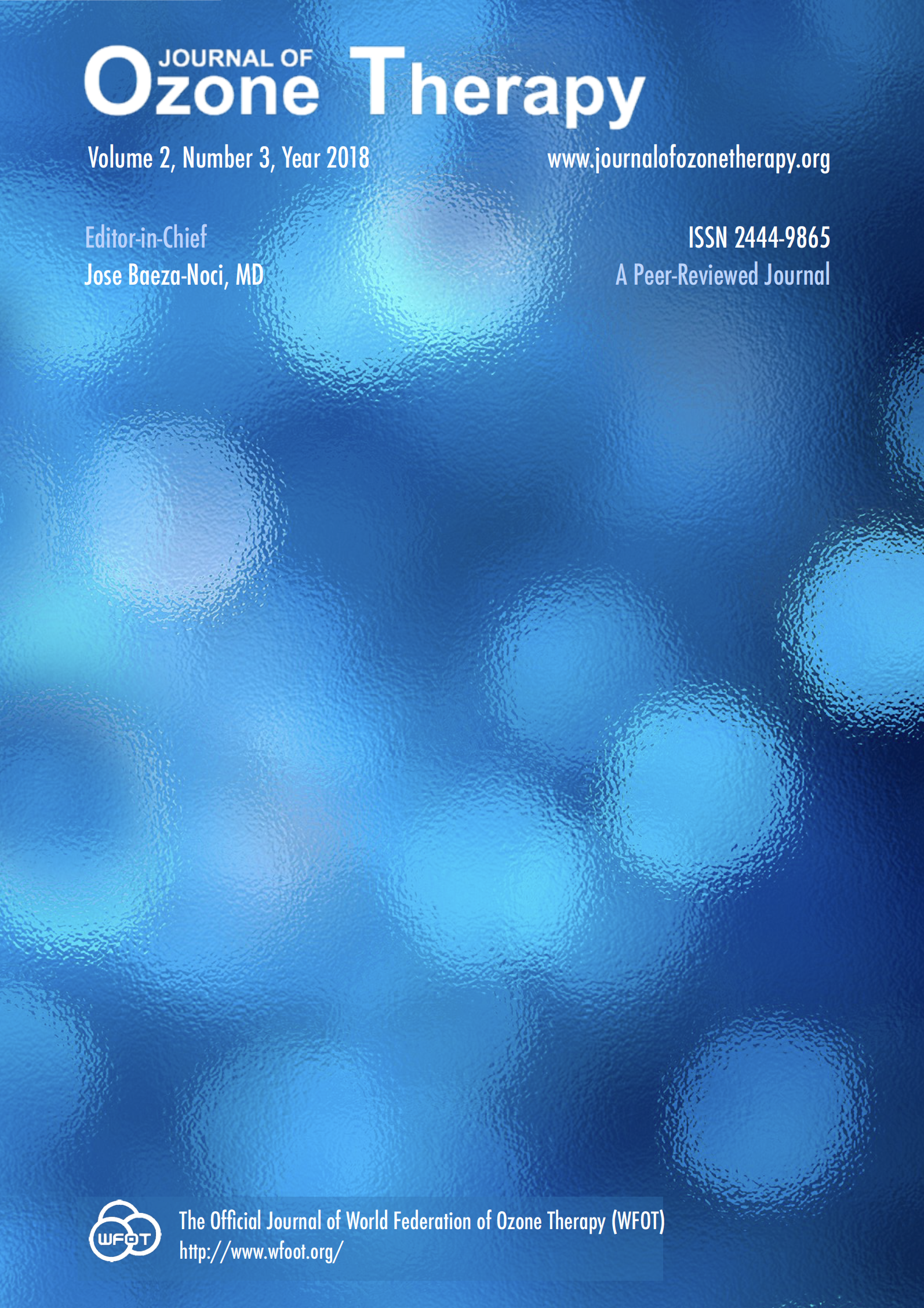Ozone therapy in idiopathic carpal tunnel syndrome. Biochemical, neurophysiological and clinical aspects
DOI :
https://doi.org/10.7203/jo3t.2.3.2018.11286Mots-clés :
ozone therapy, carpal tunnel syndrome, ischemia reperfusion injury, oxidative stress, fibrosis, timing Résumé
Résumé
Purpose.
Idiopathic Carpal Tunnel Syndrome (CTS) is the most common entrapment neuropathy; however few and only retrospective studies have been found in search engines about Ozone Therapy.
The aim of this paper was to evaluate clinical and neurophysiological outcome following Ozone Therapy in CTS.
We focused the attention on the evidences concerning the role of Subsynovial Connective Tissue (SSCT) in the pathogenesis of CTS and the ozone pre-conditioning effects linked to pain and inflammatory pathways and to fibrosis induced by Ischemia-Reperfusion Injury.
Materials and methods.
Thirty-five patients, aged between 21 and 80, were stratified clinically by Boston Carpal Tunnel Questionnaire (B.C.T.Q.) and Neurophysiologically by Padua’s Gravity Scale classifying patients into five Electro-myographic categories. The mean symptom duration was also recorded.
The patients filled in the B.C.T.Q. before and after treatment as well underwent diagnostic neurophysiological tests, strictly standardized in stimulation parameters, electrodes placement and skin temperature.
The Ozone Therapy was performed by injecting 4 ml of O2-O3 mixture at 10 ug/ml concentration under the transverse carpal ligament twice a week for eight sessions.
Results.
We compared the B.C.T.Q. scores and the neurophysiological parameters obtained before and after O2-O3 treatment: the improvement of symptoms was significantly greater than the improvement of motor and sensory nerve conduction.
The highest clinical improvement degree was found in patients classified in Mild and Moderate Groups.
Discussion and Conclusion.
Ischemia-Reperfusion Injury triggers oxidative stress in SSCT with activation of chemical mediators and neo-angiogenesis leading to non-inflammatory fibrosis that represent the allmark of CTS.
Previous and retrospective studies based O2-O3 treatment on the main mechanisms of action shared by the treatment of herniated disc in the spine; our study focused the attention on pathophysiology of the SSCT trying to recognize the various stages of CTS pathogenesis by correlating with clinical and neuro-physiological tests.
Further studies have to be carried out to better understand these relationships and optimize timing of Ozone Therapy.
 Téléchargements
Téléchargements
 Références
Références
Alfonso C, Jann S, Massa R, Torreggiani A. Diagnosis, treatment and follow-up of the carpal tunnel syndrome: a review. Neurolog Sci. 2010;31(3):243-252. doi: 10.1007/s10072-009-0213-9.
Katre A, Ballinger C, Akhter H, Fanucchi M, Kim DK, Postlethwait E, et al. Increased transforming growth factor beta 1 expression mediates ozone-induced airway fibrosis in mice. Inhal Toxicol. 2011;23(8):486-494. doi: 10.3109/08958378.2011.584919.
Bocci V, Luzzi E, Corradeschi F, Silvestri S. Studies on the biological effects of ozone. Production of transforming growth factor 1 by human blood after ozone treatment. J Biol Regul Homeost Agents. 1994;8(4):108-112.
Valacci G, Bocci V. Studies on the biological effects of ozone. Release of factors from ozonated human platelets. Mediators Inflamm. 1999;8(4-5):205-209.
Bonetti M. Oxygen-Ozone Therapy: Brief historical review and mechanism of action. Int J Ozone Ther. 2007;6(2):143-144.
Xing B, Chen H, Wang L, Weng X, Chen Z, Li X. Ozone oxidative preconditioning protects the rat kidney from reperfusion injury via modulation of the TLR4-NF-KB pathway. Acta Cir Bras. 2015;30(1):60-6. doi: 10.1590/S0102-86502015001000008.
Chammas M, Boretto J, Burmann LM, Ramos RM, Dos-Santos-Neto FC, et al. Carpal tunnel syndrome – Part I (anatomy, physiology, etiology and diagnosis). Rev Bras Ortop. 2014;49(5):429-36. doi: 10.1016/j.rboe.2014.08.001.
Chan L, Turner JA, Comstock BA, Levenson LM, Hollingworth W, Heagerty PJ, et al. The relationship between electrodiagnostic findings and patient symptoms and function in carpal tunnel syndrome. Arch Phys Med Rehabil. 2007;88(1):19-24.
Chikenji T, Gingery A, Zhao C, Passe SM, Ozasa Y, Larson D, et al. Trasforming growth factor-β (TGF-β) expression is increased in the subsynovial connective tissues of patients with idiopathic carpal tunnel syndrome. J Orthop Res. 2014;32(1):116-122. doi: 10.1002/jor.22485.
Ciliberti S, Marchese D, D’Andrea M, Meliado R, Fratto L, Amendola GAM, et al. Sindrome del tunnel carpale: Review [Carpal tunnel syndrome: review] [Internet]. Consenza: Editore Claudio Constanzo; 2015[cited 2019 Mar 15]. Available from: https://portale.ilcentrotirreno.it/pubblicazioni-scientifiche/745-sindrome-del-tunnel-carpale-review.html
Deger AN, Deger H, Taser F. The role of neoangiogenesis and vascular endothelial growth factor in the development of carpal tunnel syndrome in patients with diabets. Niger J Clin Pract. 2016;19(2):189-95. doi: 10.4103/1119-3077.175971.
Di-Silvestri CA, Cosentino P, Buscema A, Pizzolo S, Condorelli G. Diagnosi e trattamento della sindrome del tunnel carpale [Diagnoses and treatment of carpal tunnel syndrome] [Internet]. [place unknown]: Fisiobrain; 2013[cited 2019 Mar 15]. Available from: http://www.fisiobrain.com/web/2013/diagnosie-trattamento-della-sindrome-del-tunnel-carpale
Ettema AM, Amadio PC, Zhao C, Wold LE, An KN. A histological and immunohistochemical study of the subsynovial connective tissue in idiopathic carpal tunnel syndrome. J Bone Joint Surg Am. 2004;86A(7):1458-1466.
Tucci MA, Barbieri RA, Freeland AE. Biochemical and histological analysis of the flexor tenosynovium in patients with carpal tunnel syndrome. Biomed Sci Instrum. 1997;33:246-251.
Sud V, Freeland AE. Biochemistry of carpal tunnel syndrome. Microsurgery. 2005;25(1):44-46. doi: 10.1002/micr.20071.
Freeland AE, Tucci MA, Barbieri RA, Angel MF, Nick TG. Biochemical evaluation of serum and flexor tenosynovium in carpal tunnel syndrome. Microsurgery. 2002;22(8):378-85.
Gingery A, Yang TH, Passe SM, An KN, Zhao C, Amadio PC. TGF-β signaling regulates fibrotic expression and activity in carpal tunnel syndrome. J Orthop Res. 2014;32(11):1444-1450. doi: 10.1002/jor.22694.
Chikenji T, Gingery A, Zhao C, Passe SM, Ozasa Y, Larson D, et al. Transforming growth factor‐β (TGF‐β) expression is increased in the subsynovial connective tissues of patients with idiopathic carpal tunnel syndrome. J Orthop Res. 2014;32(1):116-122. doi: 10.1002/jor.22485.
Seol GH, Kang P, Lee HS, Seol GH. Antioxidant activity of linalool in patients with carpal tunnel syndrome. BMC Neurol. 2016;16:17. doi: 10.1186/s12883-016-0541-3.
Hirata H, Tsujii M, Yoshida T, Imanaka-Yoshida K, Morita A, Okuyama N, et al. MMP-2 expression is associated with rapidly proliferative arteriosclerosis in the flexor tenosynovium and pain severity in carpal tunnel syndrome. J Pathol. 2005;205:443-450.
Jinrok O, Zhao C, Amadio PC, An KN, Zobitz ME, Wold LE. Vascular pathologic changes in the flexor tenosynovium (subsynovial connective tissue) in idiopathic carpal tunnel syndrome. J Orthop Res. 2004;22(6):1310-1315. doi: 10.1016/j.orthres.2004.03.005.
Yamanaka Y, Gingery A, Oki G, Yang TH, Zhao C, Amadio PC. Blocking fibrotic signaling in fibroblasts from patients with carpal tunnel syndrome. J Cell Physiol. 2018;233(3):2067-2074. doi: 10.1002/jcp.25901.
Kang YM, Lee HM, Moon SH, Kang H, Choi YR. Relaxin modulates the expression of MMPs and TIMPs in fibroblasts of patients with carpal tunnel syndrome. Yonsei Med J. 2017;58(2):415-422. doi: 10.3349/ymj.2017.58.2.415.
Levine DW, Simmons BP, Koris MJ, Daltroy LH, Hohl GG, Fossel AH, et al. A self-administered questionnaire for the assessment of severity of symptoms and functional status in carpal tunnel syndrome. J Bone Joint Surg Am. 1993;75(11):1585-1592.
Wang L, Chen H, Liu XH, Chen ZY, Weng XD, Qiu T, et al. Ozone oxidative preconditioning inhibits renal fibrosis induced by ischemia and reperfusion injury in rats. Exp Ther Med. 2014;8(6):1764-1768. doi: 10.3892/etm.2014.2004.
Kal A, Kal O, Akillioglu I, Celik E, Yilmaz M, Gonul S, et al. The protective effect of prophylactic ozone administration against retinal ischemia-reperfusion injury. Cutan Ocul Toxicol. 2017;36(1):39-47. doi: 10.3109/15569527.2016.1156120.
Kim JK, Koh YD, Kim JS, Hann HJ, Kim MJ. Oxidative stress in subsynovial connective tissue of idiopathic carpal tunnel syndrome. J Orthop Res. 2010;28(11):1462-1468. doi: 10.1002/jor.21163.
Meng W, Xu Y, Li D, Zhu E, Deng L, Liu Z, et al. Ozone protects rat heart against ischemia-reperfusion injury: a role for oxidative preconditioning in attenuation mitochondrial injury. Biomed Pharmacother. 2017;88:1090-1097. doi: 10.1016/j.biopha.2017.01.151.
Baeza-Noci J, Cabo-Soler JR, Moraleda-Gomez M, Menendez-Cepedo S, Re L. WFOT’s Review on Evidence Based Ozone Therapy [Internet]. Brescia: WFOT; 2015[cited 2019 Mar 15]. Available from: https://www.wfoot.org/wp-content/uploads/2016/01/WFOT-OZONE-2015-ENG.pdf.
Onal M, Elsurer C, Selimoglu N, Yilmaz M, Erdogan E, Bengi-Celik J, et al. Ozone prevents cochlear damage from ischemia-reperfusion injury in Guinea pigs. Artif Organs. 2017;41(8):744-752. doi: 10.1111/aor.12863.
Onal O, Yetisir F, Sarer AE, Zeybek ND, Onal CO, Yurekli B, et al. Prophylactic ozone administration reduces intestinal mucosa injury induced by intestinal ischemia-reperfusion in the rat. Mediators Inflamm. 2015;2015:792016. doi: 10.1155/2015/792016.
Padua L, Padua R, Aprile I, Amico P, Tonali P. Carpal tunnel syndrome: relationship between clinical and patient-oriented assessment. Clin Orthop Relat Res. 2002;395:128.
Padua L, Lo-Monaco M, Padua R, Gregori B, Tonali P. Neurophysiological classification of carpal tunnel syndrome: assessment of 600 symptomatic hands. Ital J Neurol Sci. 1997;18(3):145-150.
Padua R, Padua L, Romanini E, Aulisa L, Lupparelli S, Sanguinetti C. Versione italiana del questionario “Boston Carpal Tunnel”: valutazione preliminare [Italian version of “Boston Carpal Tunnel” questionaire: preliminary valutation]. G Ital Ortop Traum. 1998;24(1):121-129.
Ramonda R, Punzi L, Vangelista T, Todesco S. Analisi critica delle manovre semeiologiche proposte per la diagnosi di sindrome del tunnel carpale [Critical analysis of the manoeuvres proposed for the diagnosis of the tunnel carpal syndrome]. Reumatismo. 2002;54(2):156-164.
Re L, Sanchez G. M, Mawsouf N. Clinical evidence of ozone interaction with pain mediators. Saudi Med J. 2011;32(12):1363-1367.
Scarchilli A. Sindrome del tunnel carpale (STC) [Carpal tunnel Syndrome (CTS)]. Int J Ozone Ther. 2009;8(2):150-152.
Somay H, Emon ST, Uslu S, Orakdogen M, Meric ZC, Ince U, et al. The histological effects of ozone therapy on sciatic nerve crush injury in rats. World Neurosurg. 2017;105:702-708. doi: 10.1016/j.wneu.2017.05.161.
Chikenji T, Gingery A, Zhao C, Vanhees M, Moriya T, Reisdorf R, et al. Transforming growth factor-β (TGF-β) expression is increased in the subsynovial connective tissue in a rabbit model of carpal tunnel syndrome. PLoS One. 2014;9(9):108312. doi: 10.1371/journal.pone.0108312.
Tat J, Wilson KE, Keir PJ. Pathological changes in the subsynovial connective tissue increase with self-reported carpal tunnel syndrome symptoms. Clin Biomech (Bristol, Avon). 2015;30(4):360-365. doi: 10.1016/j.clinbiomech.2015.02.015.
Tsujii M, Hirata H, Morita A, Uchida A. Palmar bowing of the flexor retinaculum on wrist MRI correlates with subjective reports of pain in carpal tunnel syndrome. J Magn Reson Imaging. 2009;29(5):1102-5. doi: 10.1002/jmri.21459.
Tusat M, Mentese A, Demir S, Alver A, Imamoglu M. Medical Ozone therapy reduces oxidative stress and testicular damage in an experimental model of testicular torsion in rats. Int Braz J Urol. 2017;43(6):1160-1166. doi: 10.1590/S1677-5538.IBJU.2016.0546.
Werthel JD, Zhao C, An KN, Amadio PC. Carpal tunnel syndrome pathophysiology: role of subsynovial connective tissue. J Wrist Surg. 2014;3(4):220-6. doi: 10.1055/s-0034-1394133.
Zambello A, Fumagalli L, Fara B, Bianchi MM. Oxigen-ozone treatment of carpal tunnel syndrome. Retrospective study and literature review of conservative and surgical techiques. Int J Ozone Ther. 2008;7(1):45-48.
Zanardi I, Borrelli E, Valacchi G, Travagli V, Bocci V. Ozone: Multifaceted Molecule with Unexpected Therapeutic Activity. Curr Med Chem. 2016;23(4):304-14.
Zhang J, Guan M, Xie C, Luo X, Zhang Q, Xue Y. Increased growth factors play a role in wound healing promoted by noninvasive oxygen-ozone therapy in diabetic patients with foot ulcers. Oxid Med Cell Longev. 2014;2014:273475. doi: 10.1155/2014/273475.
Téléchargements
Publié-e
Comment citer
-
Résumé1843
-
PDF 581
Numéro
Rubrique
Licence
Journal of Ozone Therapy applies the Creative Commons Attribution-NonCommercial 4.0 International License (CC BY NC 4.0) license to works we publish.
Under this license, authors retain ownership of the copyright for their content, but allow anyone to download, reuse, reprint, modify, distribute and/or copy the content as long as the original authors and source are cited. No permission is required from the authors or the publishers.
You may not use the material for commercial purposes.
Appropriate attribution can be provided by simply citing the original article, provide a link to the license, and indicate if changes were made.
You may do so in any reasonable manner, but not in any way that suggests the licensor endorses you or your use.




